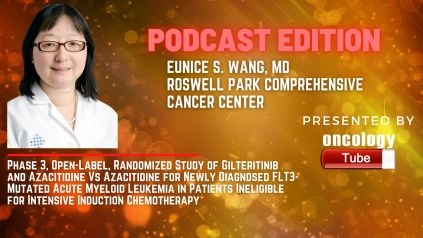Dr. Eunice Wang is the Director of the Roswell Park Comprehensive Cancer Center’s Leukemia Service. Dr. Wang joined the Roswell Park faculty in 2003 and was assigned to the Department of Medicine’s Leukemia Service. She received her medical degree from the University of Southern California’s Keck School of Medicine and finished her residency in Internal Medicine at Yale-New Haven Hospital, Yale University, New Haven, CT, in 1999. She did a clinical hematology-oncology and research residency at Memorial Sloan Kettering Cancer Center in New York, NY, from 1999 to 2003. In this video Dr. Wang discusses the Open-Label, Randomized Study of Gilteritinib and Azacitidine Vs Azacitidine for Newly Diagnosed FLT3-Mutated Acute Myeloid Leukemia in Patients Ineligible for Intensive Induction Chemotherapy.
Link to Abstract-
https://ash.confex.com/ash/2021/webprogram/Paper145379.html
Background: Gilteritinib (GIL), a FLT3 inhibitor, has shown efficacy and safety in FLT3mut+ relapsed/refractory (R/R) AML patients. Survival is poor for patients with newly diagnosed (ND) AML with FLT3 mutations who are unable to receive intense induction chemotherapy (IIC), and treatment options are restricted. GIL with azacitidine (AZA) inhibited tumor development and caused apoptosis/differentiation in FLT3-ITD AML cell lines in preclinical experiments. In xenografted mice models, antitumor effects appeared to be synergistic (data on file). In people with ND FLT3mut+ AML who were not eligible for IIC, we compared GIL+AZA to AZA (NCT02752035).
The goal of this study was to compare the effectiveness, safety, and tolerability of GIL+AZA and AZA in patients with ND FLT3mut+ AML who were not eligible for IIC.
During 28-day cycles, participants were randomly assigned (1:1:1) to GIL (120 mg/day orally on Days 1-28) plus AZA (75 mg/m2/day SC/IV on Days 1-7), AZA (same regimen), or GIL (same regimen). Due to recommended therapy adjustments, the GIL arm was removed. The participants were then randomly assigned (2:1) to receive GIL+AZA or AZA alone. Overall survival (OS) was the primary endpoint, and event-free survival (EFS) was a key secondary endpoint (EFS). If complete remission (CR) was not obtained after 6 cycles, the treatment failure date was the randomization date. Subgroup and sensitivity analyses were planned ahead of time. The study looked at response rates, safety/tolerance, and pharmacokinetic outcomes. Data from a three-year follow-up period was acquired, as well as information on subsequent AML treatment. These findings are based on a preliminary examination of 70 deaths (50 percent of all deaths).
As of August 26, 2020, 123 patients have been randomized to GIL+AZA (n=74) or AZA (n=49), with 39 (52.7%) and 31 (63.3%) fatalities, respectively. With GIL+AZA, the median age was 78 years, and with AZA, it was 76 years; ECOG PS 2 was 47.3 percent and 32.7 percent, respectively, while FLT3-ITD alone was 78.4 percent and 81.6 percent (TKD alone 18.9 percent vs 14.3 percent ; ITD with TKD 2.7 percent vs 4.1 percent ). GIL+AZA had a median follow-up of 9.76 months, while AZA had a median follow-up of 17.97 months. The median period of GIL exposure in the GIL+AZA arm (n=73) was 112 days, while AZA exposure was 98 and 99 days in the GIL+AZA and AZA (n=47) arms, respectively. 20.3 percent of GIL+AZA patients and 44.9 percent of AZA patients had additional AML therapy; the median duration to first subsequent therapy was 8.2 and 4.5 months, respectively. In the AZA arm, 22 patients were treated for AML, with 10 receiving GIL and 4 receiving other FLT3 inhibitors. GIL+AZA had a median OS of 9.82 months, while AZA had an OS of 8.87 months (HR 0.916 [95 percent CI 0.529, 1.585]; P=.753). Patients with ECOG PS 0-1 (HR 0.811 [95 percent CI 0.409, 1.608]) and a high FLT3-ITD allelic ratio 0.5 had better OS with GIL+AZA vs AZA (HR 0.580 [95 percent CI 0.285, 1.182]). In all arms, the median EFS was 0.03 months (HR 1.175 [95 percent CI 0.764, 1.807]; P=.459). In sensitivity analyses, GIL+AZA had a median EFS of 5.03 months and AZA had a median EFS of 3.29 months (HR 0.924 [95 percent CI 0.576, 1.482]; P=.767) with events based on composite CR (CRc; CR+CRi+CRp). CRc rates were considerably higher with GIL+AZA vs AZA (58.1 vs 26.5 percent, difference 31.4 percent [95 percent CI 13.1, 49.7]; P.001), despite identical CR rates (16.2 percent vs 14.3 percent). The overall adverse event (AE; GIL+AZA, 100%; AZA, 95.7%) and grade 3 AE rates (95.9% and 89.4%, respectively) were identical in both arms. Treatment-related adverse events resulted in the death of four patients in each arm. Pyrexia (47.9%) and diarrhea (47.9%) were the most common AEs with GIL+AZA (38.4 percent ). Following AML therapy, more pts with baseline ECOG PS 2 in the GIL+AZA arm, and a study design adjustment could all have contributed to the OS outcomes.
GIL trough concentrations at steady state (Ctrough) did not differ significantly between GIL+AZA and GIL alone (prior to arm removal). However, median GIL Ctrough was 579 ng/mL on Cycle 1 Day 15 (GIL+AZA and GIL arms), compared to 279 ng/mL with GIL alone in the ADMIRAL study in patients with R/R AML. The reasons for this disparity are being investigated. There was no clear link between Ctrough and thrombocytopenia or neutropenia response rates or grade.
Conclusions: GIL+AZA resulted in significantly greater CRc rates but similar OS compared to AZA alone in this trial of patients with ND FLT3mut+ AML who were ineligible for IIC. Patients with ECOG PS 0-1 and a high FLT3-ITD allelic ratio seemed to benefit more from GIL+AZA. There were no new safety signals visible. Ctrough values were 2-fold higher in pts with ND FLT3mut+ AML ineligible for IIC than in pts with R/R FLT3mut+ AML. These findings back up GIL+AZA’s safety, tolerability, and activity over AZA.

